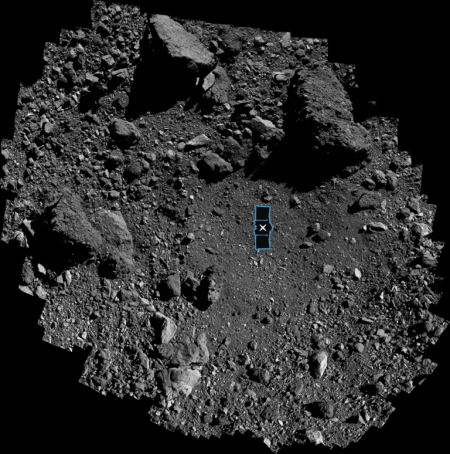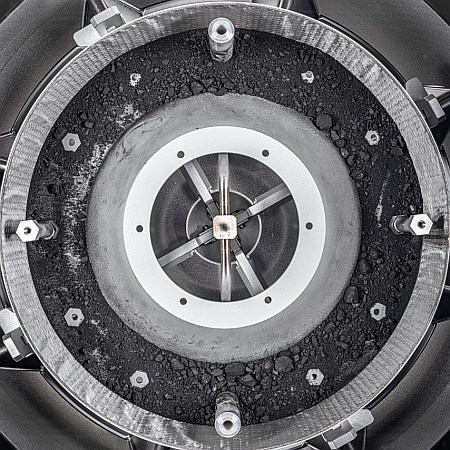Samples from the asteroid Bennu reshape entirely our understanding of the solar system’s early make-up

The sample site on Bennu, with OSIRIS-REx
superimposed for scale. Click for full image.
First, I hope my readers will notice that — unlike NASA and the entire press — I make no mention in my headline above of the discovery of a “mix of life’s ingredients” or “the key building blocks of life” from the samples brought back by the probe OSIRIS-REx from the asteroid Bennu.
This is the game NASA does all the time, to hint at the discovery of life when this is not the real discovery. NASA does it because it knows that if you hint at such a discovery, the press will go crazy and give you lots of press.
The real news from the two papers published this week, available here and here, however, is more fundamental. Before the samples from Bennu and Ryugu (brought back by the Japanese probe Hayabusa-2) had arrived, our understanding of the make-up and chemistry of the early solar system was very incomplete and badly biased. The only asteroid samples we had of carbonaceous chondrite asteroids, the most primitive and fragile carbon-rich asteroids in the solar system, had came from meteorites that had survived the journey through the Earth’s atmosphere. Thus, the only material that survived was robust enough to do so. The more fragile molecules however were always destroyed and thus missing from meteorites, even though it was very clear from spectroscopy of these asteroids in the solar system that such molecules did exist, and likely formed the majority of these asteroids’ make-up.
Thus, though carbonaceous chondrite asteroids represent the early solar system, our understanding of them was warped and very incomplete. The whole point of both missions to Bennu and Ryugu was to fill in this data, to get a more complete census of the real make-up of the early solar system.
The two papers published this week have given us that. That’s their real discovery.
Nor is it at all surprising that the samples had many organic molecules, including many fundamental to life, because these asteroids are carbon-rich. For those who don’t know, organic molecules are by definition molecules that contain carbon. If you have an asteroid with a lot of carbon, it is going to have a lot of organic molecules. And since many of these molecules are fragile and are destroyed during re-entry, they have been missing in previous studies of meteorites.
They aren’t missing any more. Their detection in Bennu tells us much about nature of our solar system today. As noted in the abstract of the second paper linked to above, which focused on the discovery of molecules formed during the evaporation of brines, “Similar brines probably still occur in the interior of icy bodies Ceres and Enceladus, as indicated by spectra or measurement of sodium carbonate on the surface or in plumes.”
More important, the data also speaks to the solar system’s early nature. From the first paper’s abstract:
Organic matter in meteorites reveals clues about early Solar System chemistry and the origin of molecules important to life, but terrestrial exposure complicates interpretation. Samples returned from the B-type asteroid Bennu by [OSIRIS-Rex] enabled us to study pristine carbonaceous astromaterial without uncontrolled exposure to Earth’s biosphere.
Here we show that Bennu samples are volatile rich, with more carbon, nitrogen and ammonia than samples from asteroid Ryugu and most meteorites. Nitrogen-15 isotopic enrichments indicate that ammonia and other N-containing soluble molecules formed in a cold molecular cloud or the outer protoplanetary disk. We detected amino acids (including 14 of the 20 used in terrestrial biology), amines, formaldehyde, carboxylic acids, polycyclic aromatic hydrocarbons and N-heterocycles (including all five nucleobases found in DNA and RNA), along with ~10,000 N-bearing chemical species.
…The relative abundances of amino acids and other soluble organics suggest formation and alteration by low-temperature reactions, possibly in NH3-rich fluids. Bennu’s parent asteroid developed in or accreted ices from a reservoir in the outer Solar System where ammonia ice was stable.

The inside of OSIRIS-REx’s sample return
capsule. Click for original image.
In other words, the data has opened a window into the true nature of our early solar system and the chemical processes that took place as the accretion disk of dust and small objects began to coalesce into the planets.
Does this data suggest that our solar system was conducive to the formation of life? Yes, without question. Is this really a surprise? No, not really. Today’s solar system has life, here on Earth, and thus the ingredients to make that possible had to have existed when the solar system began forming.
The data from the Bennu samples however gives us our first accurate glimpse into the processes that occurred in the beginning. It also gives us a better understanding of the similar processes still taking place today on asteroids and the outer planets and moons.
From this scientists will be better able to decipher the strange geological processes they see on alien worlds, both here and around other stars, and thus explain them more accurately. And that’s the real discovery here.
On Christmas Eve 1968 three Americans became the first humans to visit another world. What they did to celebrate was unexpected and profound, and will be remembered throughout all human history. Genesis: the Story of Apollo 8, Robert Zimmerman's classic history of humanity's first journey to another world, tells that story, and it is now available as both an ebook and an audiobook, both with a foreword by Valerie Anders and a new introduction by Robert Zimmerman.
The print edition can be purchased at Amazon or from any other book seller. If you want an autographed copy the price is $60 for the hardback and $45 for the paperback, plus $8 shipping for each. Go here for purchasing details. The ebook is available everywhere for $5.99 (before discount) at amazon, or direct from my ebook publisher, ebookit. If you buy it from ebookit you don't support the big tech companies and the author gets a bigger cut much sooner.
The audiobook is also available at all these vendors, and is also free with a 30-day trial membership to Audible.
"Not simply about one mission, [Genesis] is also the history of America's quest for the moon... Zimmerman has done a masterful job of tying disparate events together into a solid account of one of America's greatest human triumphs."--San Antonio Express-News


RZ says: Today’s solar system has life, here on Earth, and thus the ingredients to make that possible had to have existed when the solar system began forming.”
Proposed correction: “Today’s solar system has life, here on Earth with life friendly locales on Enceladus, Europa and Mars, and thus ….”
This is working a lot like water on Mars, the closer we look, the more we find. No actual life as yet, but more friendly places we find. Sooner or later the friendly places become actual places. A great, great detective story we are all currently involved in. Cheers –
Indeed…. Using the Copernican principal, this analysis probably means that the ingredients for life are widespread thru the universe, and thus the likelihood of extraterrestrial life increases… Great news for us ET fans!
The fact it proves the ingredients for life are plentiful in our own solar system bodes well for life past and present in our neighborhood… I am looking forward to ESA’s ExoMars rover ( or whatever it’s called these days ), which will be the first rover with the intention of seeking out bio signatures, and these results increase the chance it might find positive results.
It’s also a shame that Beagle 2 did not fully deploy, after ( Whatever our host claims ) a fully successful landing on Mars.. Had it managed to deploy it’s last solar panel we might have had interesting data already.
Whatever, I’m betting on ESA getting proof of past or present life on Mars before the US or China, which means I’m also betting that there was/is life on our red neighbor.
And at the end of the day, it doesn’t really matter who returns the science, apart from the bragging rights, which are nothing apart from a chance to wind up the patrons on Behind the black ;-)
Lee S wrote: “And at the end of the day, it doesn’t really matter who returns the science, apart from the bragging rights,”
Actually, it does matter who returns the science. If it is someone who is in a rush and does not make sure he does a good job, then his science may be of low quality. I would prefer the science from people who take the time and effort to ensure that the data is precise, small error bars, and that it is accurate, the true value is within those error bars.
Climate science has been destroyed by people who were not careful but who adjusted datasets without informing anyone, without explaining the reason to adjust the data collected (not the data processed, as they did), and consistently in the direction that supported their favored hypothesis. Each of these three actions alone is a sign of fudged data. It does matter who returns the science.